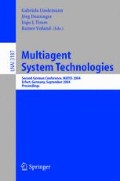Abstract
This paper presents an application of agent technology to the field of communication security. The proposed method, Split and Merge, is presented. The generic approach is on the denying of access to the message, instead of ciphering the message at the source and then sending it over a communication channel. This is achieved by splitting the message in parts and sending them to the destination through different routes, in an ad-hoc network of cooperating agents. The implementation of the method using multi-agent systems is detailed. The solutions found to deal with error detection and correction (loss of message fragments, message integrity and node misbehavior) are then discussed. An emphasis is put on the use reputation and trust mechanisms, with a fuzzy approach, to detect and cope with nodes with different levels of reliability.
Access this chapter
Tax calculation will be finalised at checkout
Purchases are for personal use only
Preview
Unable to display preview. Download preview PDF.
References
Diffie, W., Hellman, M.E.: New Directions in Cryptography. IEEE Transactions on Information Theory IT-22(6), 644–654 (1976)
Rivest, R.L., Adleman, L.M.: A method for obtaining digital signatures and publickey cryptosystems. Communications of the ACM 2(21), 120–126 (1978)
Webopedia, Moore’s law (1998), http://www.webopedia.com/TERM/M/Moores_Law.html
Mann, C.C.: The End of Moore’s Law? Technology Review (2000), http://www.technologyreview.com/articles/mann0500.asp
Rónai, C.: O Globo 08/2000 (2000), http://www.almaden.ibm.com/projects/oglobo.htm
: NCIX, Counterintelligence News & Developments. Hidden in Plain Sight-Steganography 1998, Office of the National Counterintelligence Executive. 2 (1998)
Judge, J.C.: Steganography: Past, Present, Future, SANS - SysAdmin, Audit, Network, Security (2001), http://www.sans.org/rr/steg/steganography4.php
Reiter, M.K., Rubin, A.D.: Crowds: Anonymity for Web Transactions. In: DIMACS, New Jersey, USA, p. 21 (1997)
Goldschlag, D.M., Reed, M.G., Syverson, P.F.: Hiding Routing Information. In: Anderson, R. (ed.) IH 1996 (LLNCS), vol. 1174, Springer, Heidelberg (1996)
Goldschlag, D., Reed, M., Syverson, P.: Onion Routing for Anonymous and Private Internet Connections. Communications of the ACM 42(2) (1999)
Bosselaers, A.: Comparative performance of hash functions, http://www.esat.kuleuven.ac.be/~bosselae/fast.html
Barreto, P.: The Hashing Function Lounge (2000), http://planeta.terra.com.br/informatica/paulobarreto/hflounge.html
Gambetta, D.: Can We Trust Trust? in Trust: Making and Breaking Cooperative Relations, electronic edition. In: Gambetta, D. (ed.) Department of Sociology, pp. 213–237. University of Oxford, Oxford (2000), http://www.sociology.ox.ac.uk/papers/gambetta213-237.pdf
Mui, L.: Computational Models of Trust and Reputation: Agents, Evolutionary Games, and Social Networks. In: in Department of Electrical Engineering and Computer Science 2002, Massachusetts Institute of Technology, Massachusetts, p. 139 (2002)
Ostrom, E.: A Behavioral Approach to the Rational-Choice Theory of Collective Action. American Political Science Review 92(1), 1–22 (1998)
Granovetter, M.: Economic Action and Social Structure: The Problem of Embeddedness. American Journal of Sociology 91, 481–510 (1985)
Willmott, S., et al.: Agentcities Network Architecture Recommendation, Agentcities Task Force (2002)
Bellifemine, F., Poggi, A., Rimassa, G.: JADE - A FIPA-compliant agent framework. In: 4th International Conference and Exhibition on the Practical Application of Intelligent Agents and Multi-Agents, London, UK (1999)
FIPA00061, FIPA ACL Message Structure Specification. In: Foundation for Intelligent Physical Agents (2000)
Author information
Authors and Affiliations
Editor information
Editors and Affiliations
Rights and permissions
Copyright information
© 2004 Springer-Verlag Berlin Heidelberg
About this paper
Cite this paper
Pimentão, J.P., Sousa, P.A.C., Amaral, P., Steiger-Garção, A. (2004). Agent-Based Communication Security. In: Lindemann, G., Denzinger, J., Timm, I.J., Unland, R. (eds) Multiagent System Technologies. MATES 2004. Lecture Notes in Computer Science(), vol 3187. Springer, Berlin, Heidelberg. https://doi.org/10.1007/978-3-540-30082-3_6
Download citation
DOI: https://doi.org/10.1007/978-3-540-30082-3_6
Publisher Name: Springer, Berlin, Heidelberg
Print ISBN: 978-3-540-23222-3
Online ISBN: 978-3-540-30082-3
eBook Packages: Springer Book Archive

